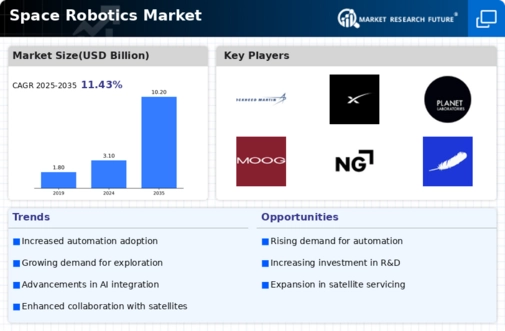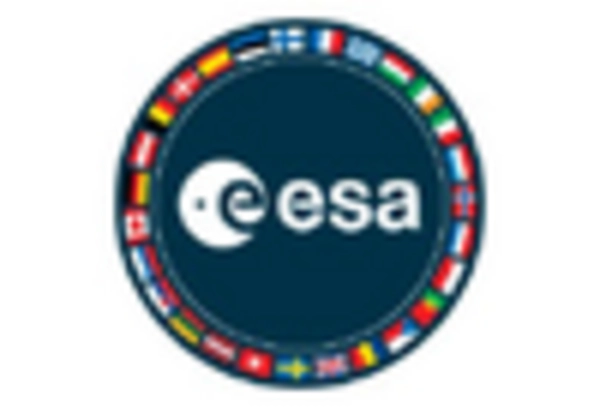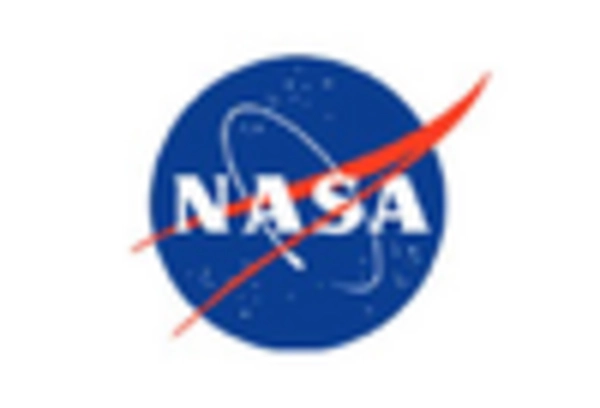Satellite Servicing
Planetary Exploration
Space Construction
Space Debris Removal
Autonomous Operations
Robotic Arms
Mobile Robots
Remote Operated Vehicles
Autonomous Drones
Manipulation
Inspection
Transportation
Maintenance
Government
Commercial
Research Institutions
North America
Europe
South America
Asia Pacific
Middle East and Africa
North America Outlook (USD Billion, 2019-2035)
North America Space Robotics Market by Application Type
Satellite Servicing
Planetary Exploration
Space Construction
Space Debris Removal
Autonomous Operations
North America Space Robotics Market by Type
Robotic Arms
Mobile Robots
Remote Operated Vehicles
Autonomous Drones
North America Space Robotics Market by Functionality Type
Manipulation
Inspection
Transportation
Maintenance
North America Space Robotics Market by End Use Type
Government
Commercial
Research Institutions
North America Space Robotics Market by Regional Type
US
Canada
US Outlook (USD Billion, 2019-2035)
US Space Robotics Market by Application Type
Satellite Servicing
Planetary Exploration
Space Construction
Space Debris Removal
Autonomous Operations
US Space Robotics Market by Type
Robotic Arms
Mobile Robots
Remote Operated Vehicles
Autonomous Drones
US Space Robotics Market by Functionality Type
Manipulation
Inspection
Transportation
Maintenance
US Space Robotics Market by End Use Type
Government
Commercial
Research Institutions
CANADA Outlook (USD Billion, 2019-2035)
CANADA Space Robotics Market by Application Type
Satellite Servicing
Planetary Exploration
Space Construction
Space Debris Removal
Autonomous Operations
CANADA Space Robotics Market by Type
Robotic Arms
Mobile Robots
Remote Operated Vehicles
Autonomous Drones
CANADA Space Robotics Market by Functionality Type
Manipulation
Inspection
Transportation
Maintenance
CANADA Space Robotics Market by End Use Type
Government
Commercial
Research Institutions
Europe Outlook (USD Billion, 2019-2035)
Europe Space Robotics Market by Application Type
Satellite Servicing
Planetary Exploration
Space Construction
Space Debris Removal
Autonomous Operations
Europe Space Robotics Market by Type
Robotic Arms
Mobile Robots
Remote Operated Vehicles
Autonomous Drones
Europe Space Robotics Market by Functionality Type
Manipulation
Inspection
Transportation
Maintenance
Europe Space Robotics Market by End Use Type
Government
Commercial
Research Institutions
Europe Space Robotics Market by Regional Type
Germany
UK
France
Russia
Italy
Spain
Rest of Europe
GERMANY Outlook (USD Billion, 2019-2035)
GERMANY Space Robotics Market by Application Type
Satellite Servicing
Planetary Exploration
Space Construction
Space Debris Removal
Autonomous Operations
GERMANY Space Robotics Market by Type
Robotic Arms
Mobile Robots
Remote Operated Vehicles
Autonomous Drones
GERMANY Space Robotics Market by Functionality Type
Manipulation
Inspection
Transportation
Maintenance
GERMANY Space Robotics Market by End Use Type
Government
Commercial
Research Institutions
UK Outlook (USD Billion, 2019-2035)
UK Space Robotics Market by Application Type
Satellite Servicing
Planetary Exploration
Space Construction
Space Debris Removal
Autonomous Operations
UK Space Robotics Market by Type
Robotic Arms
Mobile Robots
Remote Operated Vehicles
Autonomous Drones
UK Space Robotics Market by Functionality Type
Manipulation
Inspection
Transportation
Maintenance
UK Space Robotics Market by End Use Type
Government
Commercial
Research Institutions
FRANCE Outlook (USD Billion, 2019-2035)
FRANCE Space Robotics Market by Application Type
Satellite Servicing
Planetary Exploration
Space Construction
Space Debris Removal
Autonomous Operations
FRANCE Space Robotics Market by Type
Robotic Arms
Mobile Robots
Remote Operated Vehicles
Autonomous Drones
FRANCE Space Robotics Market by Functionality Type
Manipulation
Inspection
Transportation
Maintenance
FRANCE Space Robotics Market by End Use Type
Government
Commercial
Research Institutions
RUSSIA Outlook (USD Billion, 2019-2035)
RUSSIA Space Robotics Market by Application Type
Satellite Servicing
Planetary Exploration
Space Construction
Space Debris Removal
Autonomous Operations
RUSSIA Space Robotics Market by Type
Robotic Arms
Mobile Robots
Remote Operated Vehicles
Autonomous Drones
RUSSIA Space Robotics Market by Functionality Type
Manipulation
Inspection
Transportation
Maintenance
RUSSIA Space Robotics Market by End Use Type
Government
Commercial
Research Institutions
ITALY Outlook (USD Billion, 2019-2035)
ITALY Space Robotics Market by Application Type
Satellite Servicing
Planetary Exploration
Space Construction
Space Debris Removal
Autonomous Operations
ITALY Space Robotics Market by Type
Robotic Arms
Mobile Robots
Remote Operated Vehicles
Autonomous Drones
ITALY Space Robotics Market by Functionality Type
Manipulation
Inspection
Transportation
Maintenance
ITALY Space Robotics Market by End Use Type
Government
Commercial
Research Institutions
SPAIN Outlook (USD Billion, 2019-2035)
SPAIN Space Robotics Market by Application Type
Satellite Servicing
Planetary Exploration
Space Construction
Space Debris Removal
Autonomous Operations
SPAIN Space Robotics Market by Type
Robotic Arms
Mobile Robots
Remote Operated Vehicles
Autonomous Drones
SPAIN Space Robotics Market by Functionality Type
Manipulation
Inspection
Transportation
Maintenance
SPAIN Space Robotics Market by End Use Type
Government
Commercial
Research Institutions
REST OF EUROPE Outlook (USD Billion, 2019-2035)
REST OF EUROPE Space Robotics Market by Application Type
Satellite Servicing
Planetary Exploration
Space Construction
Space Debris Removal
Autonomous Operations
REST OF EUROPE Space Robotics Market by Type
Robotic Arms
Mobile Robots
Remote Operated Vehicles
Autonomous Drones
REST OF EUROPE Space Robotics Market by Functionality Type
Manipulation
Inspection
Transportation
Maintenance
REST OF EUROPE Space Robotics Market by End Use Type
Government
Commercial
Research Institutions
APAC Outlook (USD Billion, 2019-2035)
APAC Space Robotics Market by Application Type
Satellite Servicing
Planetary Exploration
Space Construction
Space Debris Removal
Autonomous Operations
APAC Space Robotics Market by Type
Robotic Arms
Mobile Robots
Remote Operated Vehicles
Autonomous Drones
APAC Space Robotics Market by Functionality Type
Manipulation
Inspection
Transportation
Maintenance
APAC Space Robotics Market by End Use Type
Government
Commercial
Research Institutions
APAC Space Robotics Market by Regional Type
China
India
Japan
South Korea
Malaysia
Thailand
Indonesia
Rest of APAC
CHINA Outlook (USD Billion, 2019-2035)
CHINA Space Robotics Market by Application Type
Satellite Servicing
Planetary Exploration
Space Construction
Space Debris Removal
Autonomous Operations
CHINA Space Robotics Market by Type
Robotic Arms
Mobile Robots
Remote Operated Vehicles
Autonomous Drones
CHINA Space Robotics Market by Functionality Type
Manipulation
Inspection
Transportation
Maintenance
CHINA Space Robotics Market by End Use Type
Government
Commercial
Research Institutions
INDIA Outlook (USD Billion, 2019-2035)
INDIA Space Robotics Market by Application Type
Satellite Servicing
Planetary Exploration
Space Construction
Space Debris Removal
Autonomous Operations
INDIA Space Robotics Market by Type
Robotic Arms
Mobile Robots
Remote Operated Vehicles
Autonomous Drones
INDIA Space Robotics Market by Functionality Type
Manipulation
Inspection
Transportation
Maintenance
INDIA Space Robotics Market by End Use Type
Government
Commercial
Research Institutions
JAPAN Outlook (USD Billion, 2019-2035)
JAPAN Space Robotics Market by Application Type
Satellite Servicing
Planetary Exploration
Space Construction
Space Debris Removal
Autonomous Operations
JAPAN Space Robotics Market by Type
Robotic Arms
Mobile Robots
Remote Operated Vehicles
Autonomous Drones
JAPAN Space Robotics Market by Functionality Type
Manipulation
Inspection
Transportation
Maintenance
JAPAN Space Robotics Market by End Use Type
Government
Commercial
Research Institutions
SOUTH KOREA Outlook (USD Billion, 2019-2035)
SOUTH KOREA Space Robotics Market by Application Type
Satellite Servicing
Planetary Exploration
Space Construction
Space Debris Removal
Autonomous Operations
SOUTH KOREA Space Robotics Market by Type
Robotic Arms
Mobile Robots
Remote Operated Vehicles
Autonomous Drones
SOUTH KOREA Space Robotics Market by Functionality Type
Manipulation
Inspection
Transportation
Maintenance
SOUTH KOREA Space Robotics Market by End Use Type
Government
Commercial
Research Institutions
MALAYSIA Outlook (USD Billion, 2019-2035)
MALAYSIA Space Robotics Market by Application Type
Satellite Servicing
Planetary Exploration
Space Construction
Space Debris Removal
Autonomous Operations
MALAYSIA Space Robotics Market by Type
Robotic Arms
Mobile Robots
Remote Operated Vehicles
Autonomous Drones
MALAYSIA Space Robotics Market by Functionality Type
Manipulation
Inspection
Transportation
Maintenance
MALAYSIA Space Robotics Market by End Use Type
Government
Commercial
Research Institutions
THAILAND Outlook (USD Billion, 2019-2035)
THAILAND Space Robotics Market by Application Type
Satellite Servicing
Planetary Exploration
Space Construction
Space Debris Removal
Autonomous Operations
THAILAND Space Robotics Market by Type
Robotic Arms
Mobile Robots
Remote Operated Vehicles
Autonomous Drones
THAILAND Space Robotics Market by Functionality Type
Manipulation
Inspection
Transportation
Maintenance
THAILAND Space Robotics Market by End Use Type
Government
Commercial
Research Institutions
INDONESIA Outlook (USD Billion, 2019-2035)
INDONESIA Space Robotics Market by Application Type
Satellite Servicing
Planetary Exploration
Space Construction
Space Debris Removal
Autonomous Operations
INDONESIA Space Robotics Market by Type
Robotic Arms
Mobile Robots
Remote Operated Vehicles
Autonomous Drones
INDONESIA Space Robotics Market by Functionality Type
Manipulation
Inspection
Transportation
Maintenance
INDONESIA Space Robotics Market by End Use Type
Government
Commercial
Research Institutions
REST OF APAC Outlook (USD Billion, 2019-2035)
REST OF APAC Space Robotics Market by Application Type
Satellite Servicing
Planetary Exploration
Space Construction
Space Debris Removal
Autonomous Operations
REST OF APAC Space Robotics Market by Type
Robotic Arms
Mobile Robots
Remote Operated Vehicles
Autonomous Drones
REST OF APAC Space Robotics Market by Functionality Type
Manipulation
Inspection
Transportation
Maintenance
REST OF APAC Space Robotics Market by End Use Type
Government
Commercial
Research Institutions
South America Outlook (USD Billion, 2019-2035)
South America Space Robotics Market by Application Type
Satellite Servicing
Planetary Exploration
Space Construction
Space Debris Removal
Autonomous Operations
South America Space Robotics Market by Type
Robotic Arms
Mobile Robots
Remote Operated Vehicles
Autonomous Drones
South America Space Robotics Market by Functionality Type
Manipulation
Inspection
Transportation
Maintenance
South America Space Robotics Market by End Use Type
Government
Commercial
Research Institutions
South America Space Robotics Market by Regional Type
Brazil
Mexico
Argentina
Rest of South America
BRAZIL Outlook (USD Billion, 2019-2035)
BRAZIL Space Robotics Market by Application Type
Satellite Servicing
Planetary Exploration
Space Construction
Space Debris Removal
Autonomous Operations
BRAZIL Space Robotics Market by Type
Robotic Arms
Mobile Robots
Remote Operated Vehicles
Autonomous Drones
BRAZIL Space Robotics Market by Functionality Type
Manipulation
Inspection
Transportation
Maintenance
BRAZIL Space Robotics Market by End Use Type
Government
Commercial
Research Institutions
MEXICO Outlook (USD Billion, 2019-2035)
MEXICO Space Robotics Market by Application Type
Satellite Servicing
Planetary Exploration
Space Construction
Space Debris Removal
Autonomous Operations
MEXICO Space Robotics Market by Type
Robotic Arms
Mobile Robots
Remote Operated Vehicles
Autonomous Drones
MEXICO Space Robotics Market by Functionality Type
Manipulation
Inspection
Transportation
Maintenance
MEXICO Space Robotics Market by End Use Type
Government
Commercial
Research Institutions
ARGENTINA Outlook (USD Billion, 2019-2035)
ARGENTINA Space Robotics Market by Application Type
Satellite Servicing
Planetary Exploration
Space Construction
Space Debris Removal
Autonomous Operations
ARGENTINA Space Robotics Market by Type
Robotic Arms
Mobile Robots
Remote Operated Vehicles
Autonomous Drones
ARGENTINA Space Robotics Market by Functionality Type
Manipulation
Inspection
Transportation
Maintenance
ARGENTINA Space Robotics Market by End Use Type
Government
Commercial
Research Institutions
REST OF SOUTH AMERICA Outlook (USD Billion, 2019-2035)
REST OF SOUTH AMERICA Space Robotics Market by Application Type
Satellite Servicing
Planetary Exploration
Space Construction
Space Debris Removal
Autonomous Operations
REST OF SOUTH AMERICA Space Robotics Market by Type
Robotic Arms
Mobile Robots
Remote Operated Vehicles
Autonomous Drones
REST OF SOUTH AMERICA Space Robotics Market by Functionality Type
Manipulation
Inspection
Transportation
Maintenance
REST OF SOUTH AMERICA Space Robotics Market by End Use Type
Government
Commercial
Research Institutions
MEA Outlook (USD Billion, 2019-2035)
MEA Space Robotics Market by Application Type
Satellite Servicing
Planetary Exploration
Space Construction
Space Debris Removal
Autonomous Operations
MEA Space Robotics Market by Type
Robotic Arms
Mobile Robots
Remote Operated Vehicles
Autonomous Drones
MEA Space Robotics Market by Functionality Type
Manipulation
Inspection
Transportation
Maintenance
MEA Space Robotics Market by End Use Type
Government
Commercial
Research Institutions
MEA Space Robotics Market by Regional Type
GCC Countries
South Africa
Rest of MEA
GCC COUNTRIES Outlook (USD Billion, 2019-2035)
GCC COUNTRIES Space Robotics Market by Application Type
Satellite Servicing
Planetary Exploration
Space Construction
Space Debris Removal
Autonomous Operations
GCC COUNTRIES Space Robotics Market by Type
Robotic Arms
Mobile Robots
Remote Operated Vehicles
Autonomous Drones
GCC COUNTRIES Space Robotics Market by Functionality Type
Manipulation
Inspection
Transportation
Maintenance
GCC COUNTRIES Space Robotics Market by End Use Type
Government
Commercial
Research Institutions
SOUTH AFRICA Outlook (USD Billion, 2019-2035)
SOUTH AFRICA Space Robotics Market by Application Type
Satellite Servicing
Planetary Exploration
Space Construction
Space Debris Removal
Autonomous Operations
SOUTH AFRICA Space Robotics Market by Type
Robotic Arms
Mobile Robots
Remote Operated Vehicles
Autonomous Drones
SOUTH AFRICA Space Robotics Market by Functionality Type
Manipulation
Inspection
Transportation
Maintenance
SOUTH AFRICA Space Robotics Market by End Use Type
Government
Commercial
Research Institutions
REST OF MEA Outlook (USD Billion, 2019-2035)
REST OF MEA Space Robotics Market by Application Type
Satellite Servicing
Planetary Exploration
Space Construction
Space Debris Removal
Autonomous Operations
REST OF MEA Space Robotics Market by Type
Robotic Arms
Mobile Robots
Remote Operated Vehicles
Autonomous Drones
REST OF MEA Space Robotics Market by Functionality Type
Manipulation
Inspection
Transportation
Maintenance
REST OF MEA Space Robotics Market by End Use Type
Government
Commercial
Research Institutions

















Leave a Comment